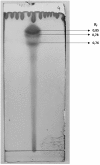Biosurfactants produced by Scheffersomyces stipitis cultured in sugarcane bagasse hydrolysate as new green larvicides for the control of Aedes aegypti, a vector of neglected tropical diseases
- PMID: 29125845
- PMCID: PMC5695273
- DOI: 10.1371/journal.pone.0187125
Biosurfactants produced by Scheffersomyces stipitis cultured in sugarcane bagasse hydrolysate as new green larvicides for the control of Aedes aegypti, a vector of neglected tropical diseases
Abstract
Biosurfactants are microbial metabolites with possible applications in various industrial sectors that are considered ecofriendly molecules. In recent years, some studies identified these compounds as alternatives for the elimination of vectors of tropical diseases, such as Aedes aegypti. The major bottlenecks of biosurfactant industrial production have been the use of conventional raw materials that increase production costs as well as opportunistic or pathogenic bacteria, which restrict the application of these biomolecules. The present study shows the potential of hemicellulosic sugarcane bagasse hydrolysate as a raw material for the production of a crystalline glycolipidic BS by Scheffersomyces stipitis NRRL Y-7124, which resulted in an emulsifying index (EI24) of 70 ± 3.4% and a superficial tension of 52 ± 2.9 mN.m-1. Additionally, a possible new application of these compounds as biolarvicides, mainly against A. aegypti, was evaluated. At a concentration of 800 mg.L-1, the produced biosurfactant caused destruction to the larval exoskeletons 12 h after application and presented an letal concentration (LC50) of 660 mg.L-1. Thus, a new alternative for biosurfactant production using vegetal biomass as raw material within the concept of biorefineries was proposed, and the potential of the crystalline glycolipidic biosurfactant in larvicidal formulations against neglected tropical disease vectors was demonstrated.
Conflict of interest statement
Figures






Similar articles
-
Eco-friendly biosurfactant from Wickerhamomyces anomalus CCMA 0358 as larvicidal and antimicrobial.Microbiol Res. 2020 Dec;241:126571. doi: 10.1016/j.micres.2020.126571. Epub 2020 Aug 9. Microbiol Res. 2020. PMID: 32818706
-
Larvicidal activity of Ottonia anisum metabolites against Aedes aegypti: A potential natural alternative source for mosquito vector control in Brazil.J Vector Borne Dis. 2017 Jan-Mar;54(1):61-68. J Vector Borne Dis. 2017. PMID: 28352047
-
Pseudomonas aeruginosa Rhamnolipids Produced by Andiroba (Carapa guianensis Aubl.) (Sapindales: Meliaceae) Biomass Waste from Amazon: A Potential Weapon Against Aedes aegypti L. (Diptera: Culicidae).Molecules. 2025 Jan 31;30(3):618. doi: 10.3390/molecules30030618. Molecules. 2025. PMID: 39942722 Free PMC article.
-
Extract of Bowdichia virgilioides and maackiain as larvicidal agent against Aedes aegypti mosquito.Exp Parasitol. 2015 Jun;153:160-4. doi: 10.1016/j.exppara.2015.03.018. Epub 2015 Mar 24. Exp Parasitol. 2015. PMID: 25819294
-
Larvicidal and phytochemical properties of Callistemon rigidus R. Br. (Myrtaceae) leaf solvent extracts against three vector mosquitoes.J Vector Borne Dis. 2014 Sep;51(3):216-23. J Vector Borne Dis. 2014. PMID: 25253215
Cited by
-
In vitro nematicidal and acaricidal effect of biosurfactants produced by Bacillus against the root-knot nematode Nacobbus aberrans and the dust mite Tyrophagus putrescentiae.Braz J Microbiol. 2023 Jun;54(2):1127-1136. doi: 10.1007/s42770-023-00981-9. Epub 2023 Apr 29. Braz J Microbiol. 2023. PMID: 37119435 Free PMC article.
-
Interactive analysis of biosurfactants in fruit-waste fermentation samples using BioSurfDB and MEGAN.Sci Rep. 2022 May 11;12(1):7769. doi: 10.1038/s41598-022-11753-0. Sci Rep. 2022. PMID: 35546170 Free PMC article.
-
Evaluation of (-)-borneol derivatives against the Zika vector, Aedes aegypti and a non-target species, Artemia sp.Environ Sci Pollut Res Int. 2018 Nov;25(31):31165-31174. doi: 10.1007/s11356-018-2809-1. Epub 2018 Sep 5. Environ Sci Pollut Res Int. 2018. PMID: 30187415
-
Fungal biosurfactants, from nature to biotechnological product: bioprospection, production and potential applications.Bioprocess Biosyst Eng. 2021 Oct;44(10):2003-2034. doi: 10.1007/s00449-021-02597-5. Epub 2021 Jun 16. Bioprocess Biosyst Eng. 2021. PMID: 34131819 Free PMC article. Review.
References
-
- Fontes GC, Amaral PFF, Coelho MAZ. Produção de biossurfactante por levedura. Química Nova. 2005; 31: 2091–2099.
-
- Gudina EJ, Rangarajan V, Sen R, Rodrigues LR. Potential therapeutic applications of biosurfactants. Trends in Pharmacological Sciences. 2013; 34:667–675. doi: 10.1016/j.tips.2013.10.002 - DOI - PubMed
-
- Barth G, Gaillard C. Physiology and genetics of the dimorphic fungus Yarrowia lipolytica. FEMS Microbiology Reviews. 1997; 19: 219–237. - PubMed
-
- Liu J-F, Mbadinga SM, Yang S-Z, Gu J-D, Mu B-Z. Chemical Structure, Property and Potential Applications of Biosurfactants Produced by Bacillus subtilis in Petroleum Recovery and Spill Mitigation. Hu X, ed. International Journal of Molecular Sciences. 2015; 16: 4814–4837. doi: 10.3390/ijms16034814 - DOI - PMC - PubMed
MeSH terms
Substances
LinkOut - more resources
Full Text Sources
Other Literature Sources

